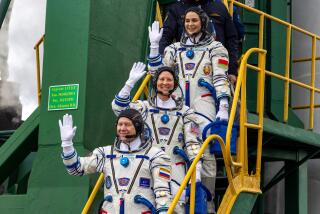A tale of two astronauts: Scott and Mark Kelly begin new phase of NASA Twins Study
After nearly a year on the International Space Station, NASA astronaut Scott Kelly returned to Earth on Tuesday night, completing, along with Russian cosmonaut Mikhail Kornienko, the longest continuous stay in space.
Kelly, Kornienko and his fellow cosmonaut Sergey Volkov touched down in Kazakhstan at 10:26 a.m. Wednesday (8:26 p.m. Tuesday Pacific time). The Soyuz TMA-18M spacecraft that ferried them back from the space station landed southeast of the remote town of Dzhezkazgan, NASA said.
Kelly will fly to NASA’s Johnson Space Center in Houston, where, after a brief rest, he’ll be examined by a bevy of scientists itching to examine him and gather samples.
But Kelly won’t be alone. He’ll be joined by his identical twin, retired NASA astronaut Mark Kelly. The pair have been participating in what might be the most far-out twin study ever conducted.
This unique study “is absolutely essential if we’re ever going to send people to Mars,” said John Holdren, director of the White House Office of Science and Technology Policy and President Obama’s senior science advisor. Holdren said he planned to meet Kelly on the tarmac upon his return to Houston on Wednesday.
While Scott Kelly has orbited the planet for 340 days, his brother Mark has remained on Earth. Because their genetics are practically identical, the brothers are offering scientists an unprecedented opportunity to understand the many different effects that space travel can have on the human body.
Studies of the astronauts will allow NASA to see the physical and psychological effects of extended stays in space, Sen. Bill Nelson (D-Fla.), a former astronaut who spent six days in orbit aboard the space shuttle Columbia in 1986, said in a statement.
“As we prepare to go all the way to Mars in the decade of the 2030s, there’s going to be a lot that we’re going to have to learn,” Nelson said.
While the idea is nothing new – every astronaut that spends time on the space station is basically a willing human test subject – this stay was unprecedented in length, as well as for the parallel Twins Study that used Mark Kelly essentially as a control subject.
The Twins Study consists of 10 different experiments from several different research institutions, together examining how life in space affects human health.
“When you go up in space there’s no gravity, so all this fluid shifts upward towards the head and it causes a number of issues for astronauts,” said Brinda Rana, a molecular geneticist at UC San Diego who is involved in two of the 10 research projects.
The most harmless of microgravity’s effects also seems to be the most visible, she added – astronauts’ faces look puffy in space.
But there are many more concerning health issues related to this fluid shift in the body, she said, including the raising of intracranial pressure, visual impairment, and inflammation potentially linked to cardiovascular disease, among others.
Several of the studies have ordered up samples from both 52-year-old brothers, including blood, urine, feces, cheek cells and spit. One of the studies looks at how the immune system responds to flu vaccines given at different points in time. Other research examines the telomeres that sit at the end of strands of DNA, in search of signs of aging and stress. There is even a psychological study that examines a strange phenomenon known as “space fog” — a lack of alertness reported by multiple astronauts.
The research doesn’t end with Kelly’s return from orbit: The scientists will continue to monitor both brothers to tease out any long-term effects of a year in orbit.
Follow @aminawrite on Twitter for more science news and “like” Los Angeles Times Science & Health on Facebook.







